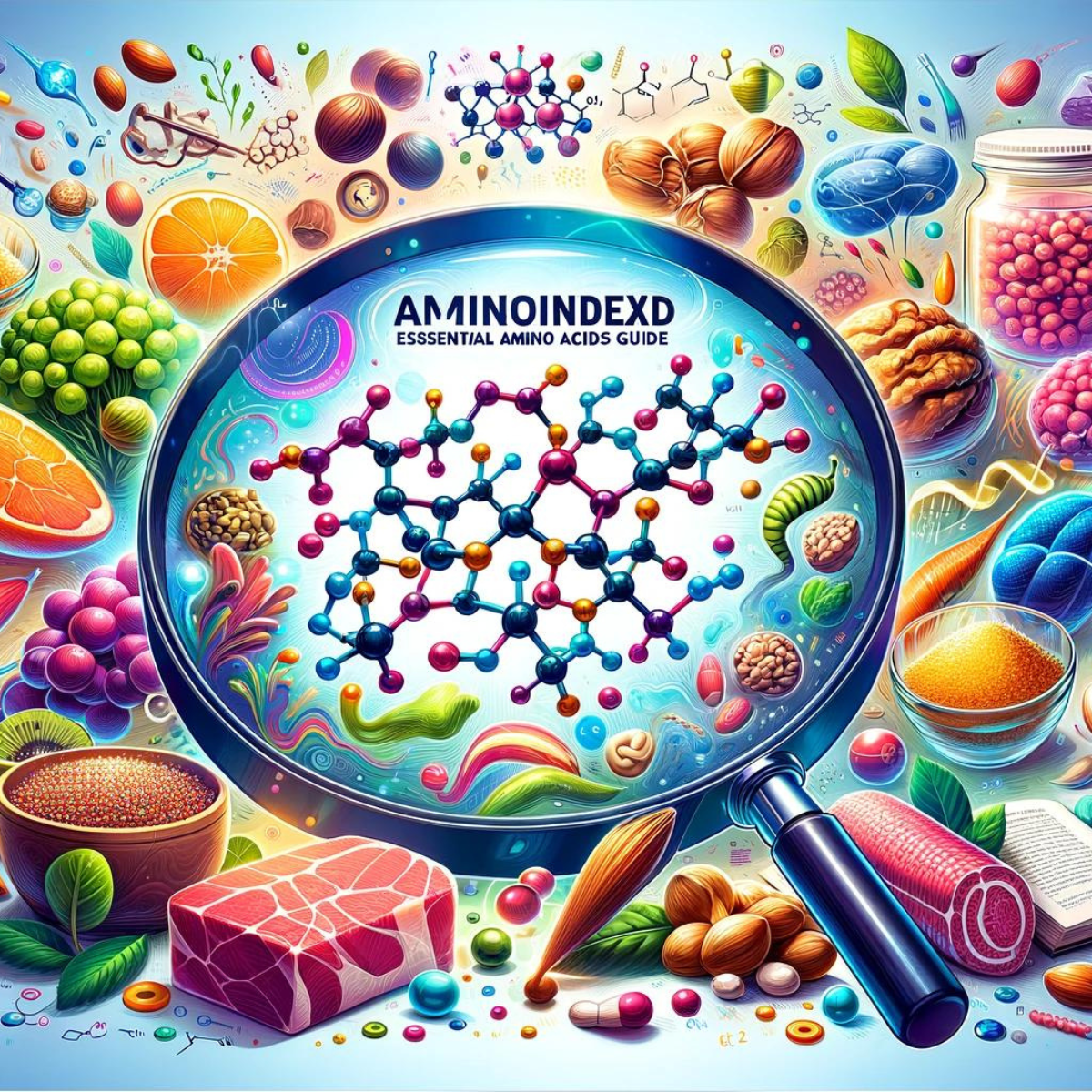Table of Contents
- Introduction
- Understanding Histamines
- Demystifying Antihistamines
- Identifying Histamine Intolerance
- Diagnostic Approaches for Histamine Intolerance
- Histamine Intolerance vs. Mast Cell Activation Syndrome (MCAS)
- Effective Strategies for Managing Histamine Levels
- Dietary Management of Histamine Intolerance
- Supplements for Supporting Histamine Intolerance
- Case Studies or Real-Life Examples
- FAQ: Frequently Asked Questions
- Conclusion
- Disclaimer
Introduction
Imagine navigating through a persistent fog that blankets your daily life, obscuring clarity and comfort. This is often the reality for those experiencing histamine intolerance—a baffling condition that masquerades as other health issues, making it difficult to pinpoint and address. In "Lifting the Histamine Fog: From Symptoms to Solutions," we peel back the layers of confusion surrounding this elusive disorder.
By understanding histamine and its potential adverse reactions in your body, you gain the power to identify if you're affected. We'll shed light on the common—and often overlooked—symptoms that could indicate histamine imbalance. You can control your health with this knowledge and the latest diagnostic approaches. We'll also provide a roadmap of dietary adjustments, lifestyle changes, and supportive supplements to help manage your symptoms, clear the fog, and restore your quality of life.
Rest assured, we're here to enlighten your understanding and empower your health journey with actionable solutions. These theoretical solutions have been proven effective in bringing a more transparent, symptom-free future into focus. Knowing that relief is within reach, you can confidently embark on this journey.
Understanding Histamines
Histamines play a crucial role in our immune response by acting as messengers that alert the body to potential threats. When an allergen enters the system, histamines are released from storage cells called mast cells and basophils. This release triggers a series of reactions to protect the body, including increasing blood flow to affected areas and stimulating other immune responses.
However, histamines are not only involved in defending against allergens; they also regulate physiological functions in the gut, act as neurotransmitters in the brain, and control the sleep-wake cycle. This widespread involvement explains why histamine's impact can be profound and varied.
In the digestive system, histamines help regulate acid production in the stomach, aiding digestion. In the central nervous system, they contribute to the regulation of sleep, alertness, and memory. However, when histamines are overproduced or not adequately broken down, they can cause symptoms like sneezing, itching, hives, and even more severe allergic reactions.
Understanding histamines' dual role—as protectors and potential provocateurs—is essential for managing health conditions related to their imbalance, such as allergies and histamine intolerance. This section delves deeper into the science behind histamine's function and the implications of its dysregulation on our health.
Demystifying Antihistamines
Antihistamines are a class of medications widely recognized for their role in managing allergic reactions, from seasonal allergies to more acute responses. These drugs effectively block the action of histamine, a chemical your body releases during an allergic reaction.
When you encounter an allergen—pollen, pet dander, or something else—your immune system releases histamine. This release leads to the well-known symptoms of allergies, such as itching, swelling, and mucus production. Histamine achieves these effects by binding to histamine receptors on various cells, prompting them to react in ways that cause these symptoms.
Antihistamines block these receptors, specifically the H1 receptors on cells in the upper respiratory tract, skin, and blood vessels. When an antihistamine occupies these receptors, it prevents histamine from binding to them, thus stopping the chain reaction that leads to allergy symptoms. It's akin to placing a key in a lock so that no other key can be inserted to turn the lock.
There are several types of antihistamines:
- First-generation antihistamines, such as diphenhydramine (Benadryl), often cause drowsiness because they can cross the blood-brain barrier and affect the brain's histamine receptors.
- Second-generation antihistamines, like cetirizine (Zyrtec) and loratadine (Claritin), are less likely to cause drowsiness as they cannot cross into the brain.
Understanding how antihistamines work is essential for those using them to manage allergies and for appreciating their effects on overall health and well-being. This knowledge can help users decide which type of antihistamine might be most appropriate for their needs, balancing efficacy with potential side effects.
Identifying Histamine Intolerance
ntifying Histamine Intolerance: Recognizing the Signs and SymptomsHistamine intolerance arises when the body accumulates more histamine than it can efficiently break down, leading to symptoms that often mimic other health issues. Unlike allergic reactions, which are immediate and obvious, the symptoms of histamine intolerance can be subtler and more chronic, making it a challenging condition to pinpoint.
Diamine oxidase (DAO) is the enzyme primarily responsible for breaking down histamine in the digestive system. When DAO is deficient or inhibited, histamine levels in the body can rise, leading to intolerance. Factors that can affect DAO levels and activity include genetic variations, gastrointestinal diseases, and the use of certain medications.
Symptoms of histamine intolerance vary widely but typically include:
- Digestive Issues: Nausea, bloating, diarrhea, and abdominal pain.
- Skin Reactions: Hives, itching, eczema, and flushing.
- Respiratory Problems: Sneezing, nasal congestion, and asthma-like symptoms.
- Neurological Symptoms: Headaches, migraines, dizziness, and, occasionally, anxiety or difficulty concentrating.
- Cardiovascular Signs: Rapid heartbeat or fluctuations in blood pressure.
Because these symptoms overlap with many other conditions, identifying histamine intolerance often involves a process of elimination. Healthcare providers typically recommend an elimination diet, where foods high in histamine are removed from the diet for several weeks to observe if symptoms improve. If symptoms subside, reintroducing these foods one at a time can confirm whether histamine is the culprit.
It's also possible to measure the activity of DAO in the blood, though this test is not widely available and can be inconclusive. Given the complexity of diagnosis, many health professionals rely on a combination of dietary strategies and symptom tracking to effectively manage and identify histamine intolerance.
Diagnostic Approaches for Histamine Intolerance
Diagnosing histamine intolerance can be complex, primarily because its symptoms often mimic those of other allergic reactions and gastrointestinal disorders. Without a definitive test for histamine intolerance, healthcare providers usually employ a combination of methods to diagnose the condition accurately.
Primary Diagnostic Strategies
- Elimination Diet: This is the most commonly recommended approach. It involves removing high-histamine foods from the diet for a few weeks to monitor whether symptoms improve. Foods typically excluded include aged cheeses, cured meats, fermented products, and alcohol. If symptoms lessen or disappear during this period, histamine might be the cause.
- Reintroduction Phase: After the elimination diet, individual foods are gradually reintroduced into the diet one at a time. This step is critical for identifying specific triggers and assessing the tolerance level to different histamine-containing foods.
- Food Diary: Keeping a detailed record of food intake and symptoms can help correlate particular foods with the appearance of symptoms. This documentation can be invaluable in pinpointing problematic foods and patterns of reaction.
Supplementary Tests
- Blood Tests for DAO Levels: Since DAO (diamine oxidase) is the main enzyme that breaks down histamine in the gut, low levels of this enzyme can indicate an inability to process histamine properly. Blood tests to measure DAO levels can provide insights, although they are not definitive for diagnosing histamine intolerance.
- Histamine Plasma Levels: Measuring the histamine level in the blood can sometimes be helpful. However, it's important to note that histamine levels can fluctuate rapidly and may not always reflect chronic conditions.
- Genetic Testing: Emerging research suggests that specific genetic markers may be linked to reduced DAO activity. Genetic testing can sometimes identify these markers, indicating an individual's predisposition to histamine intolerance.
Challenges and Considerations
Both patients and healthcare providers must understand that diagnosing histamine intolerance is often a process of exclusion. The lack of a single, conclusive test makes it necessary to rely on a combination of dietary management, symptom observation, and sometimes laboratory tests. Cooperation and clear communication between the patient and their healthcare team is crucial to effectively diagnosing and managing histamine intolerance.
Histamine Intolerance vs. Mast Cell Activation Syndrome (MCAS)
While histamine intolerance and Mast Cell Activation Syndrome (MCAS) involve issues related to histamine in the body, they are distinct conditions with different underlying mechanisms and management strategies. Understanding the differences between these two can help in accurate diagnosis and effective treatment.
Histamine Intolerance
Histamine intolerance primarily arises from the body's inability to break down histamine adequately, leading to an overload. This condition is often linked to a deficiency or dysfunction of the enzyme diamine oxidase (DAO), which degrades histamine absorbed from the gut. The primary symptoms include digestive issues, headaches, skin rashes, and respiratory problems triggered by consuming histamine-rich foods or foods that release histamine.
Mast Cell Activation Syndrome (MCAS)
MCAS, on the other hand, involves the inappropriate release of mediators from mast cells, including but not limited to histamine. Unlike histamine intolerance, MCAS is not strictly related to ingesting histamine-rich foods. It can be triggered by various factors, including stress, physical or chemical exposure, and infections. Symptoms are more systemic and can affect multiple systems simultaneously, including cardiovascular, gastrointestinal, dermatological, and neurological systems.
Key Differences
- Trigger Sources: Histamine intolerance is generally triggered by consuming histamine-containing foods, whereas a broader range of physical, environmental, or internal factors can trigger MCAS.
- Symptom Scope: Symptoms of histamine intolerance are often more localized or specific to certain systems, mainly related to the amount of histamine in the diet. In contrast, MCAS symptoms can be more widespread and systemic, affecting multiple body systems simultaneously.
- Underlying Mechanism: The root cause of histamine intolerance is the impaired metabolism of histamine due to enzyme deficiency, whereas MCAS involves the overactive release of multiple inflammatory mediators from mast cells.
- Treatment Approach: Managing histamine intolerance often focuses on diet control and possibly supplements to support DAO activity. Treatment for MCAS may involve medications to stabilize mast cell release of histamine and other mediators, along with broader strategies to avoid identified triggers.
Diagnosis and Management
Diagnosing either condition involves carefully reviewing symptoms, dietary habits, and potential triggers, with tests that may include measuring serum tryptase (common in MCAS) or DAO and histamine levels for histamine intolerance. Treatment strategies are tailored to each condition's specific characteristics and the individual's response to various interventions.
Understanding these differences is crucial for developing effective management strategies and improving the quality of life for those affected by these challenging conditions.
Effective Strategies for Managing Histamine Levels
Maintaining balanced histamine levels is crucial for individuals suffering from histamine intolerance. Effective management involves a combination of dietary choices, lifestyle modifications, and medical interventions. Here's a detailed look at the strategies that can help manage histamine levels effectively:
Dietary Modifications
- Low-Histamine Diet: The cornerstone of managing histamine intolerance is a low-histamine diet. This involves avoiding foods high in histamine or triggering histamine release. Common foods to avoid include aged cheeses, processed meats, fermented products (like sauerkraut and vinegar), alcohol, and certain fruits and vegetables (like avocados, strawberries, and tomatoes).
- Fresh Foods: Prioritize fresh meat, freshly caught fish, and newly harvested fruits and vegetables, as histamine levels in these foods increase as they age.
- Cooking Methods: Cooking methods can also affect histamine levels. For instance, boiling can reduce histamine content more than frying or baking.
Lifestyle Changes
- Stress Management: Stress is known to trigger histamine release. Incorporating stress-reduction techniques such as yoga, meditation, or regular physical activity can help manage histamine levels.
- Healthy Gut Maintenance: Since a significant portion of histamine is broken down in the gut, maintaining gut health is essential. Probiotics help strengthen the gut lining and support the enzymes deleting histamine.
Medical Interventions
- Antihistamines: These medications can effectively manage symptoms by blocking histamine receptors in the body.
- DAO Supplements: For those with DAO deficiencies, taking diamine oxidase supplements before meals can help break down histamine in food, thereby preventing symptoms.
- Vitamin C and Other Supplements: Vitamin C is a natural antihistamine that can lower blood histamine levels. Magnesium and vitamin B6 also support DAO function and can help manage histamine levels.
Regular Monitoring and Adjustments
- Symptom Tracking: Keeping a detailed diary of food intake and symptoms can help identify personal triggers and the effectiveness of the management strategies.
- Professional Guidance: Regular consultations with healthcare providers specializing in allergies and intolerances can ensure that management strategies are tailored to individual needs and effective over time.
By implementing these strategies, individuals with histamine intolerance can help manage their condition more effectively, reducing symptoms and improving their overall quality of life. Each plan can be adjusted based on individual responses and effectiveness, highlighting the importance of a personalized approach in managing histamine levels.
Dietary Management of Histamine Intolerance
Navigating the dietary landscape with histamine intolerance involves identifying foods that trigger symptoms and understanding those that are safe to consume. Effective nutritional management can significantly reduce the discomfort associated with histamine intolerance. Here's a guide to help you make informed choices about what to eat and avoid.
Foods to Avoid
- Aged and Fermented Foods: These are high in histamine. Avoid aged cheeses, yogurt, sour cream, and fermented sausages like salami and pepperoni.
- Alcoholic Beverages: Especially wine, beer, and champagne, as they not only contain histamine but also can inhibit the enzyme that breaks down histamine.
- Fermented Vegetables: Such as sauerkraut, kimchi, and pickles.
- Processed Foods: These often contain additives that can trigger histamine release.
- Certain fish and seafood, particularly not fresh ones, like canned sardines, mackerel, and tuna.
- Leftovers: Histamine levels in food increase with storage. Fresh food is always a better option.
- Certain Fruits and Vegetables: Tomatoes, avocados, spinach, and eggplant are known to have high histamine levels or trigger histamine release.
- Vinegar and Soy Sauce: Due to their fermentation process.
Foods to Embrace
- Fresh Meat and Poultry: Cook and consume them the same day they are bought.
- Freshly Caught Fish: Eat it the same day or freeze it immediately.
- Gluten-Free Grains: Rice, quinoa, and corn are good options.
- Fresh Fruits: These are less likely to trigger histamine release, such as apples, pears, and melons.
- Certain Vegetables: Broccoli, cabbage, and bell peppers are typically well-tolerated.
- Dairy Substitutes: Coconut, rice, and hemp milk are safer alternatives.
- Herbs and Spices: Most are safe, but using fresh or dried forms without additives is essential.
Cooking Tips
- Cooking Method Matters: Boiling can help reduce histamine levels in foods, whereas grilling and frying might be less effective.
- Meal Freshness: Cook meals fresh and avoid keeping leftovers, as histamine levels can rise with time after cooking.
Additional Tips
- Trial and Error: Individual tolerance can vary, so it might be necessary to test foods in small amounts to determine personal triggers.
- Balanced Diet: Ensure that the diet remains nutritionally balanced. Consulting with a dietitian or a nutritionist who understands histamine intolerance can help plan meals that meet all dietary needs without triggering symptoms.
By carefully selecting foods and adjusting your diet, you can effectively manage symptoms of histamine intolerance, improving your quality of life while ensuring your meals are nutritious and enjoyable.
Supplements for Supporting Histamine Intolerance
Dietary changes are fundamental for those with histamine intolerance, but supplements can also be crucial in managing symptoms and improving overall well-being. Here is a guide to supplements that may help reduce the impact of histamine intolerance.
Key Supplements
- Vitamin C: Known as a natural antihistamine, Vitamin C helps degrade histamine and supports the immune system. Higher doses of Vitamin C may help lower histamine levels and alleviate symptoms.
- Quercetin: This natural flavonoid has been shown to stabilize mast cells, which reduces histamine release. Quercetin also acts as a natural antihistamine and has anti-inflammatory properties.
- Vitamin B6: This vitamin is crucial for the efficient functioning of enzymes in the body, including DAO. Supplementing with Vitamin B6 can help increase DAO activity, thereby improving histamine breakdown.
- Magnesium: A natural antihistamine, magnesium can help reduce your body's reactivity to histamine. It's also known for relaxing muscles and easing respiratory symptoms.
- Probiotics: Certain strains of probiotics, such as Lactobacillus rhamnosus and Lactobacillus plantarum, may help break down histamine and strengthen gut health, which is crucial for overall histamine management.
- Omega-3 Fatty Acids: These fatty acids have anti-inflammatory properties that can help reduce the production of inflammatory compounds related to histamine release.
Considerations Before Taking Supplements
- Consultation: Always consult a healthcare provider before starting any new supplement, especially if you take other medications or have underlying health conditions. This ensures that supplements will not interfere with other treatments or worsen your condition.
- Quality and Purity: Choose high-quality supplements from reputable manufacturers to avoid contaminants and ensure you receive the correct dosage.
- Individual Response: Individual responses to supplements can vary. Monitoring your symptoms and possibly adjusting dosages under medical guidance can help you find the most effective regimen for your needs.
By integrating these supplements into your management plan, in conjunction with dietary adjustments, you can more effectively control histamine levels and reduce the symptoms of histamine intolerance. This holistic approach can significantly enhance your quality of life.
Case Studies or Real-Life Examples
Case Study 1: Navigating Diagnosis and Dietary Adjustments
Background: Emma, a 35-year-old marketing executive, experienced frequent migraines, digestive issues, and skin rashes for years without understanding the cause.
Challenge: Despite visiting several specialists, Emma's symptoms were initially misdiagnosed as stress-related ailments. It wasn't until she kept a detailed food diary that she noticed a pattern linked to the consumption of certain foods.
Solution: With the help of a nutritionist, Emma undertook an elimination diet, which significantly alleviated her symptoms. Testing confirmed a DAO deficiency, and she started taking DAO supplements before meals, which allowed her to reintroduce some previously problematic foods in moderation.
Case Study 2: Overcoming Persistent Symptoms with Integrated Strategies
Background: John, a 42-year-old teacher, dealt with severe nasal congestion, hives, and, occasionally, asthma-like symptoms, especially after meals.
Challenge: John tried various antihistamines and allergy treatments, which offered only temporary relief. His quality of life was significantly impacted, and he felt frustrated with the lack of a long-term solution.
Solution: After consulting an allergist who specialized in food sensitivities, John was diagnosed with histamine intolerance. He began a regimen of vitamin C, quercetin, and a tailored probiotic supplement. Additionally, stress management techniques, including yoga and meditation, were integrated into his daily routine, helping to stabilize his condition further.
Case Study 3: Young Adult Managing Histamine Intolerance Through Lifestyle Changes
Background: Sarah, a 28-year-old graduate student, struggled with digestive discomfort and anxiety, which she initially attributed to the stresses of school.
Challenge: Her symptoms were erratic and sometimes debilitating. A gastroenterologist suggested that histamine could be a factor after standard treatments for IBS were ineffective.
Solution: Sarah worked with a dietitian to adopt a low-histamine diet, which brought significant relief. She also found that regular cardiovascular exercise helped manage her anxiety and improved her overall resilience to symptoms.
Lessons Learned
These case studies highlight several important lessons:
- Holistic Approach: Combining dietary changes with supplements and lifestyle modifications can provide comprehensive benefits.
- Personalization: What works for one individual may not work for another; personalizing treatment strategies is crucial.
- Proactive Management: Keeping detailed records and proactively managing symptoms can improve outcomes.
By examining these real-life examples, others suffering from similar symptoms might find strategies that resonate with their experiences, encouraging them to explore potential solutions for managing histamine intolerance effectively.
FAQ: Frequently Asked Questions
What is histamine intolerance?
Histamine intolerance occurs when there's an imbalance between the amount of histamine in your body and your body's ability to break it down, typically due to a deficiency in the enzyme diamine oxidase (DAO). This can lead to an accumulation of histamine and trigger symptoms similar to allergic reactions.
What are the common symptoms of histamine intolerance?
Symptoms can vary but often include digestive issues (such as bloating, diarrhea, and abdominal pain), skin rashes, headaches, nasal congestion, fatigue, and sometimes asthma-like symptoms.
Which foods are high in histamine?
Foods that are typically high in histamine include aged cheeses, cured meats, fermented products (like sauerkraut and soy sauce), alcohol (especially red wine and beer), and certain fish (incredibly, if not fresh).
Are there any tests for histamine intolerance?
While there is no standard test for diagnosing histamine intolerance, some methods include a histamine-free diet followed by controlled reintroduction of higher-histamine foods, measurement of DAO enzyme levels in the blood, and symptom tracking about diet.
How is histamine intolerance treated?
Management primarily involves adhering to a low-histamine diet and possibly using supplements like DAO enzymes to help break down dietary histamine. Antihistamines and other medications may also be prescribed to help control symptoms.
Can histamine intolerance be cured?
While histamine intolerance has no cure, it can be effectively managed with dietary changes and medications. With proper management, some people may find that their sensitivity to histamine decreases over time.
Is histamine intolerance the same as an allergy?
No, histamine intolerance is different from an allergy. Allergies involve the immune system's response to a foreign substance, whereas histamine intolerance is a metabolic disorder related to the breakdown of histamine within the body.
How quickly do symptoms appear after eating high-histamine foods?
Symptoms can appear within a few minutes to several hours after consuming high-histamine foods, depending on individual sensitivity and the amount of histamine in the food.
Conclusion
Managing histamine intolerance effectively is crucial for maintaining your quality of life. Armed with the insights from this guide—from identifying triggers and adjusting your diet to integrating beneficial supplements—you're now better equipped to navigate this condition. While individual experiences may vary, understanding your body's responses is critical. Regular consultations with healthcare professionals and continuous adjustments to your management plan can further enhance your well-being. Embrace these strategies to clear the histamine fog and reclaim a comfortable, symptom-free life.
Disclaimer
The information provided in this article is for educational and informational purposes only. It is not intended as medical advice and should not be used as a substitute for professional medical advice, diagnosis, or treatment. Always consult your physician or another qualified health provider for any questions regarding a medical condition. Never ignore professional medical advice or delay seeking it because of something you have read in this article. Call your doctor or emergency services immediately in case of a medical emergency. The use of any information provided in this article is solely at your own risk.



















